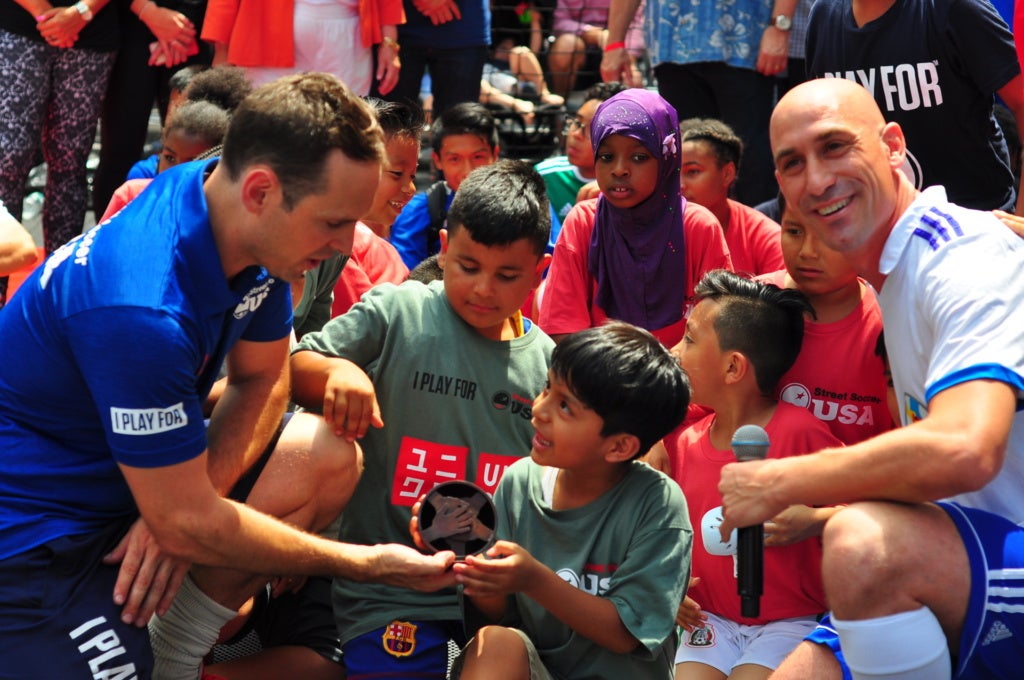
Lawrence Cann (left) began Street Soccer USA in North Carolina for the homeless. Today, he has programs in several major cities around the country that serves soccer to underserved youth. (Photo courtesy of Street Soccer USA)
There’s a common theme among the grassroots innovators helping underserved youth soccer players: Build trust. Lawrence Cann can relate. When he was 9 years old, his parents’ house burned down.
“I had a safety net because my coach picked me up for soccer practice,” Cann said. “What seemed like a bad thing was a life-affirming thing: ‘Wow, there’s a community behind me.’”
After playing college soccer, Cann volunteered at a North Carolina soup kitchen for the homeless. Cann started engaging with homeless visitors on sports. Soon, Street Soccer USA, complete with a homeless team, was created in 2008.
Street Soccer USA moved to New York and keeps growing. Now it also helps low-income, at-risk communities build youth soccer clubs and offer after-school programs. About 10,000 youth across the country get free access to a team. The overwhelming majority of the players are Hispanic and black (45 percent each), Cann said.
Street Soccer USA plays on all surfaces, including grass, so don’t take the “street” name literally. The broader idea is creating 4 v. 4, small-sided games on a 52-by-72-foot court with goals that are four feet high and 12 feet across.
“That solves a lot of logistical problems because they can be built on a basketball court,” Cann said. “We built five in New York City housing locations so the field and program is right outside where kids live. There’s a nice rec center almost a mile away, but there’s a turf war and kids can’t go across indivisible boundaries.”
Street Soccer USA has hub cities in New York, San Francisco, Chicago, Philadelphia and Sacramento. Portland, Minneapolis, Washington DC and Los Angeles are considered affiliate cities since there are fewer resources there.
Cann said funding for the no-fee model comes from revenue from pay-to-play leagues for young professionals; private philanthropy from corporate foundations or major donors; and government funding. For instance, the majority of Street Soccer USA’s funding is from New York City’s Department of Youth and Community Development.
“Soccer doesn’t have to be so expensive with the travel component and the mythology of the college scholarship,” Cann said. “You have to dispel those myths for people. If we can build the central capacity for the hard things – monitoring, data collecting, management of the program – I think you can really scale the model as an alternative to the pay-for-play model, which is corrosive by pulling players and coaches out of and away from what would be true community clubs in low-income neighborhoods.”
Street Soccer USA staffs programs not only with a head coach but also a social service manager. The organization has a life-skills curriculum.
“Training coaches is the most important thing we do,” Cann said. “The typical soccer coaching model is, ‘I show up, I deliver soccer and then I leave.’ It’s the before and after practice that are equally as important.”
Coaches come from the neighborhood of their team and receive $20 per hour. That’s far less than travel clubs usually pay, so Cann tries to compete by offering consistent and consecutive hours at one location. The goal is for the programs to eventually be run locally.
“You don’t have to be a fancy soccer coach to help kids develop,” Cann said. “It’s better to get the coaches out of the way.”
Immigrants of all ethnicities participate in Street Soccer USA. Within the past year, Hispanic parents have become reluctant to leave their house to pick up their kids, Cann said.
“I was at a parent orientation meeting recently, and I speak Spanish, and there were 30 parents and only one of them spoke English,” Cann said. “There’s a lot of trust-building that has to take place.”


